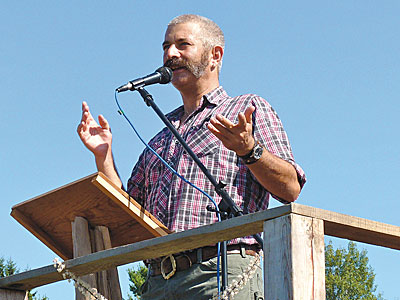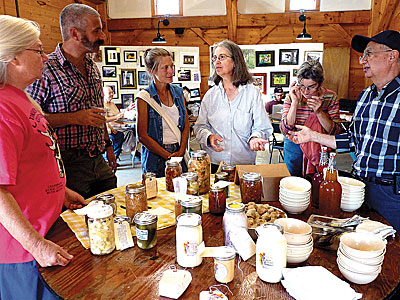 |
| Katz told fairgoers to try some fermentation and to think of themselves as agents of fermentation for social change. English photo. |
Before he wrote Wild Fermentation, published in 2003, Sandor Katz spent the summer of 2001 in Bowdoinham, where he wrote a self-published zine called Wild Fermentation. Gulf of Maine Books bought five of the 100 copies, so “my fermentation world started in Maine,” said Katz at his 2013 keynote speech at the Common Ground Country Fair.
Fermented foods – foods produced by the transformative action of microorganisms –include many common, daily foods – bread, cheese, coffee, yogurt – as well as special delicacies that people enjoy in all parts of the world. The fermentation practice is widespread and inevitable, said Katz, because plants, animals and animal products are covered with microorganisms.
Those microbes can lead to unappealing, spoiled foods, “but as a matter of survival all around the world, people figured out techniques for guiding the transformation of food, generally by manipulating environmental conditions so that we can harness the power of microorganisms to make food more stable for long-term storage, to make food more delicious … more digestible and nutritious.”
Dogma of Danger
Our perspectives on food preservation in the 21st century have become a little warped, said Katz. “Most of us have fermentation slowing devices – refrigerators – in our kitchens,” something people throughout time did not have, “and even today, the majority of people do not possess a refrigerator.
“Yet we’ve developed this food safety dogma that suggests that it’s dangerous to eat any food that has sat between 40 and 140 degrees F for more than four hours. This might be a reasonable standard to hold restaurants and food establishments to, given the presence of refrigeration, but obviously if it were dangerous to eat any food that had sat above 40 degrees for more than four hours, we wouldn’t be sitting here talking.”
 |
| Sandor Katz, with Anna (center) and Roy Antaki, judged fermented foods entered in the Exhibition Hall as volunteer Martha Gottlieb looked on. English photo. |
Many products of fermentation represent strategies to keep food edible and safe at ambient or somewhat cool temperatures but rarely at temperatures below 40 degrees. Fresh milk, Katz said, is a phenomenon of the 20th century. Before widespread refrigeration, people off the farm drank sour, or clabbered, milk. “As milk sours, it just becomes somewhat more stable.” Removing the whey enables making hard cheeses – “an extremely storable form of milk.” Likewise, yogurt, kefir and other fermented milk products made this extremely perishable food more stable. Salamis and other cured meats were strategies for preserving meat using fermentation along with other techniques.
Canning, a relatively new technology, Katz continued, has been around for about 200 years – about twice as long as refrigeration. It is called apperitization in France, after French national hero Nicolas Appert, who invented the process of canning. Before canning, people had limited methods for storing food, and fermentation was especially important in temperate areas with limited growing seasons.
“In many parts of the world,” said Katz, “human settlement never would have been possible without fermentation. I would argue that agriculture itself wouldn’t be possible without fermentation, because how could people invest their energy and resources into crops that are ready at a certain moment of the year unless they had some insight into how to effectively store those crops through the rest of the year?”
Fermentation is important today in feeding ourselves primarily from locally grown food. “Raw fruits and vegetables are not the bulk of what people are eating,” said Katz. If a farmer turns cabbages into sauerkraut, or milk into kefir, yogurt or cheese, that product is much more valuable and stable.
While centralizing and industrializing our food system meant fewer people had to be involved in the hard work of agricultural production, we have begun to wake up to the environmental and nutritional costs of that system.
“People are seeing that we need to reclaim our food,” and this has spawned a new generation of farmers, more and more home gardeners, school gardens, farmers’ markets and CSAs.
“A key piece of this that I’ve been seeing in the past two weeks as I’ve been traveling around Maine is fermentation,” said Katz.
Certain fermentation enterprises pioneered the local food revival in the United States. The emergence a couple of decades ago of small, artisan bakeries; of microbreweries; of small farmstead cheese making – these are all products of fermentation.
“I’ve been visiting a number of breweries around Maine and hearing that people are increasingly growing barley in Maine,” said Katz, “and many of the breweries are using local barley – but one step got incredibly centralized in the United States: malting – germination, sprouting. Until the last few years almost all the malting in the United States has been done in facilities you can count on two hands, most of which are quite far from Maine. In Western Massachusetts, a micro maltery has opened; some Maine brewers are taking Maine grain and getting it malted. Recreating local food systems is a complex puzzle that has all these pieces to it – lots of niches people are beginning to fill.”
Fermentation is not rocket science, said Katz, but as food production and fermentation were disappearing from people’s communities and were not being passed down from generation to generation, microbiology was emerging as a science.
“The first triumphs of microbiology were identifying pathogenic bacteria that can be dangerous to us. Certainly these exist,” said Katz, “but most bacteria are perfectly safe; we can coexist with them easily.” The emphasis on pathogenic bacteria, however, created a generalized fear of bacteria and what Katz calls a “war on bacteria.” So, many people approach the simple process of fermentation with fear.
A Strategy for Food Safety
“Something as simple and easy as sauerkraut – my gateway ferment – in about 15 minutes you can learn everything you need to make sauerkraut. The almost universal question I hear about sauerkraut is, how can I be sure I’m getting good bacteria growing and not bad bacteria? As a result of botulism, which is a risk in canning, which is the diametrical opposite of fermentation, in the cultural imagination we have projected this generalized fear on preserved foods. In fact sauerkraut is perhaps the safest food we know. Statistically, sauerkraut is much safer than raw vegetables,” which can be contaminated by manure from a nearby factory farms or by people who fail to wash their hands.
“But even if you take vegetables that have been subjected to some sort of contamination,” said Katz, and “turn them into sauerkraut, the indigenous population of lactic acid bacteria present on all plants would easily overwhelm any introduced bacteria, and as they acidify the environment, they would destroy the pathogenic bacteria. According to the USDA, the number of cases of food poisoning from fermented vegetables documented in the United States is zero. There are very few foods you can say that about. Fermentation actually is a strategy for food safety as much as anything else.”
The war on bacteria manifests as chemical warfare, said Katz, with antibiotic drugs, antibacterial cleansing products, chlorine in water – chemical compounds that compromise the bacteria in our bodies.
“The bacteria in our bodies are important,” said Katz, explaining that our bodies’ cells are outnumbered 10 to 1 by bacteria that we host – bacteria that give us a huge amount of our functionality.
“The emerging consensus in biology is that all life evolved from bacteria. The flip side of this is that no other form of life has ever lived without bacteria, and it seems like no other form of life could live without bacteria.”
In our bodies, bacteria enable us to digest food and assimilate nutrients; bacteria synthesize certain essential nutrients for us; “our” immune system is largely regulated by bacteria in our gut.
“So if you have an infection in another part of your body, the immune response to that infection is actually mediated by bacteria in your gut,” through mechanisms we only crudely understand.
For example, “production and regulation of serotonin and other chemical compounds that determine how we think and feel are regulated by gut bacteria. Even human reproduction depends upon bacteria: Women’s bodies produce a glycogen, a carbohydrate, that supports … lactic acid bacteria that create an acidic environment that is a very protective environment for human reproduction. It’s analogous to what happens in a crock of sauerkraut, when you get this acidic environment that prevents the growth of the kinds of organisms that could impede our ability to effectively reproduce, and it prevents the growth of food poisoning organisms on the cabbage and makes this such an intrinsically safe food.”
Fermenting Social Change
The metaphorical use of the word fermentation, as in cultural, political, intellectual, social and spiritual ferment, is closely related to the process of fermentation, Katz continued. “The Latin root of the word fermentation comes from the word ‘fervere,’ which means ‘to boil,’ and it’s because the visible action of fermentation in liquids is bubbles – the same as boiling.” Similarly, “yeast” comes from Greek, “zestos,” meaning “to boil,” because the visible action of yeast is the bubbles.
“So,” said Katz, “this metaphorical understanding of the word ‘fermentation’ comes from bubbles – but instead of bubbles coming from carbon dioxide in a fermenting liquid, the bubbles are people who are excited. So a period of cultural or social ferment is a period when people are excited, bubbly, irrepressible. They want to talk about ideas they’re excited about.
“So fermentation is also an engine for social change. I would think that anyone coming to the Common Ground Fair has a strong sense that our food system is a realm of our lives that desperately needs change. I hope that in addition to trying some fermentation, you can think of yourselves as agents of fermentation, as starter cultures. If you feel excited about composting or seed saving or home gardening or fermentation, that you take that excitement with you and be part of a cultural ferment to make all of these things mainstream movements, which they are becoming through the enthusiasm of the people who are practicing them and believing in them.”
Asked about health claims for fermented foods, Katz said it is not ethical to say that sauerkraut cures cancer, even though sauerkraut contains anticancer compounds. He thinks his relatively good health, despite living with HIV for about 23 years, has something to do with live culture foods and the improved digestion, nutrient assimilation and immune function they promote, but noted that he is also taking medication for HIV.
– Jean English
